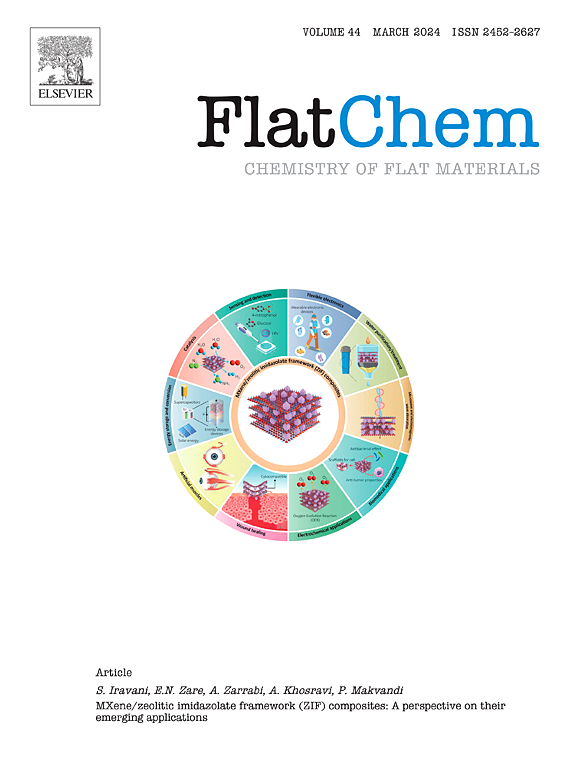Construction of BiOI/Bi2Fe4O9 heterojunction for visible-light-activated antibacterial: Photocatalytic sterilization of one plus one is greater than two
IF 6.2
3区 材料科学
Q2 CHEMISTRY, PHYSICAL
引用次数: 0
Abstract
Semiconductor photocatalysts with narrow band gaps are usually handicapped in scenarios involving visible-light photocatalytic sterilization due to the rapid recombination of photogenerated electron-hole pairs, sluggish carrier transfer kinetics, and limited reaction active sites. To address these issues, heterojunction engineering was employed to construct heterojunction photocatalyst by coupling two visible-light-activated layered photocatalysts (i.e., an n-type layered BiOI semiconductor and a p-type layered Bi2Fe4O9 semiconductor) for pathogen photoinactivation, aiming at achieving “one plus one is greater than two” photocatalytic antibacterial effect. The bacterial survival rates for single BiOI and Bi2Fe4O9 irradiated under visible light for 60 min were 54.4 % and 55.8 %, respectively. In contrast, the flower-like BiOI/Bi2Fe4O9 heterojunction with optimized component ratio possessed the lowest bacterial survival rate (2.2 %), indicating that the antibacterial activity of the coupled heterojunction photocatalyst is more than twice that of each single component photocatalyst. The instrumental results and density functional theory calculations reveal that the synergistic effect among (i) high sunlight absorption from two visible-light-activated photocatalysts, (ii) high specific surface area from the two layered materials and flower-like nanostructure, and (iii) the formation of the built-in electric field at the interface of BiOI/Bi2Fe4O9 heterojunction contributes to boosting photocatalytic antibacterial performance. Finally, we elucidate the mechanism behind the improved charge separation and transfer kinetics, •O2− and •OH production, and photocatalytic sterilization activity. This work offers a novel material design concept of “one plus one is greater than two”, which may pave the way for the development of heterojunction photocatalysts for wastewater treatment and purification.

BiOI/Bi2Fe4O9异质结在可见光抗菌中的构建:光催化杀菌1 + 1大于2
由于光电子-空穴对的快速重组、载流子转移动力学缓慢以及反应活性位点有限,具有窄带隙的半导体光催化剂通常在可见光光催化灭菌的场景中受到限制。针对这些问题,采用异质结工程技术,将两种可见光活化层状光催化剂(即n型层状bii半导体和p型层状Bi2Fe4O9半导体)偶联,构建异质结光催化剂,对病原菌进行光灭活,以达到“一加一大于二”的光催化抑菌效果。在可见光照射下,单个bii和Bi2Fe4O9的细菌存活率分别为54.4%和55.8%。相比之下,优化组分比的花状BiOI/Bi2Fe4O9异质结的细菌存活率最低(2.2%),表明偶联异质结光催化剂的抗菌活性是每种单组分光催化剂的两倍以上。实验结果和密度泛函理论计算表明,两种可见光活化光催化剂的高吸收率,两种层状材料和花状纳米结构的高比表面积,以及在bii /Bi2Fe4O9异质结界面形成的内置电场的协同效应有助于提高光催化的抗菌性能。最后,我们阐明了改善电荷分离和转移动力学,•O2−和•OH生成以及光催化杀菌活性背后的机制。本研究提出了“一加一大于二”的新型材料设计理念,为开发用于废水处理和净化的异质结光催化剂铺平了道路。
本文章由计算机程序翻译,如有差异,请以英文原文为准。
求助全文
约1分钟内获得全文
求助全文
来源期刊

FlatChem
Multiple-
CiteScore
8.40
自引率
6.50%
发文量
104
审稿时长
26 days
期刊介绍:
FlatChem - Chemistry of Flat Materials, a new voice in the community, publishes original and significant, cutting-edge research related to the chemistry of graphene and related 2D & layered materials. The overall aim of the journal is to combine the chemistry and applications of these materials, where the submission of communications, full papers, and concepts should contain chemistry in a materials context, which can be both experimental and/or theoretical. In addition to original research articles, FlatChem also offers reviews, minireviews, highlights and perspectives on the future of this research area with the scientific leaders in fields related to Flat Materials. Topics of interest include, but are not limited to, the following: -Design, synthesis, applications and investigation of graphene, graphene related materials and other 2D & layered materials (for example Silicene, Germanene, Phosphorene, MXenes, Boron nitride, Transition metal dichalcogenides) -Characterization of these materials using all forms of spectroscopy and microscopy techniques -Chemical modification or functionalization and dispersion of these materials, as well as interactions with other materials -Exploring the surface chemistry of these materials for applications in: Sensors or detectors in electrochemical/Lab on a Chip devices, Composite materials, Membranes, Environment technology, Catalysis for energy storage and conversion (for example fuel cells, supercapacitors, batteries, hydrogen storage), Biomedical technology (drug delivery, biosensing, bioimaging)
 求助内容:
求助内容: 应助结果提醒方式:
应助结果提醒方式:


